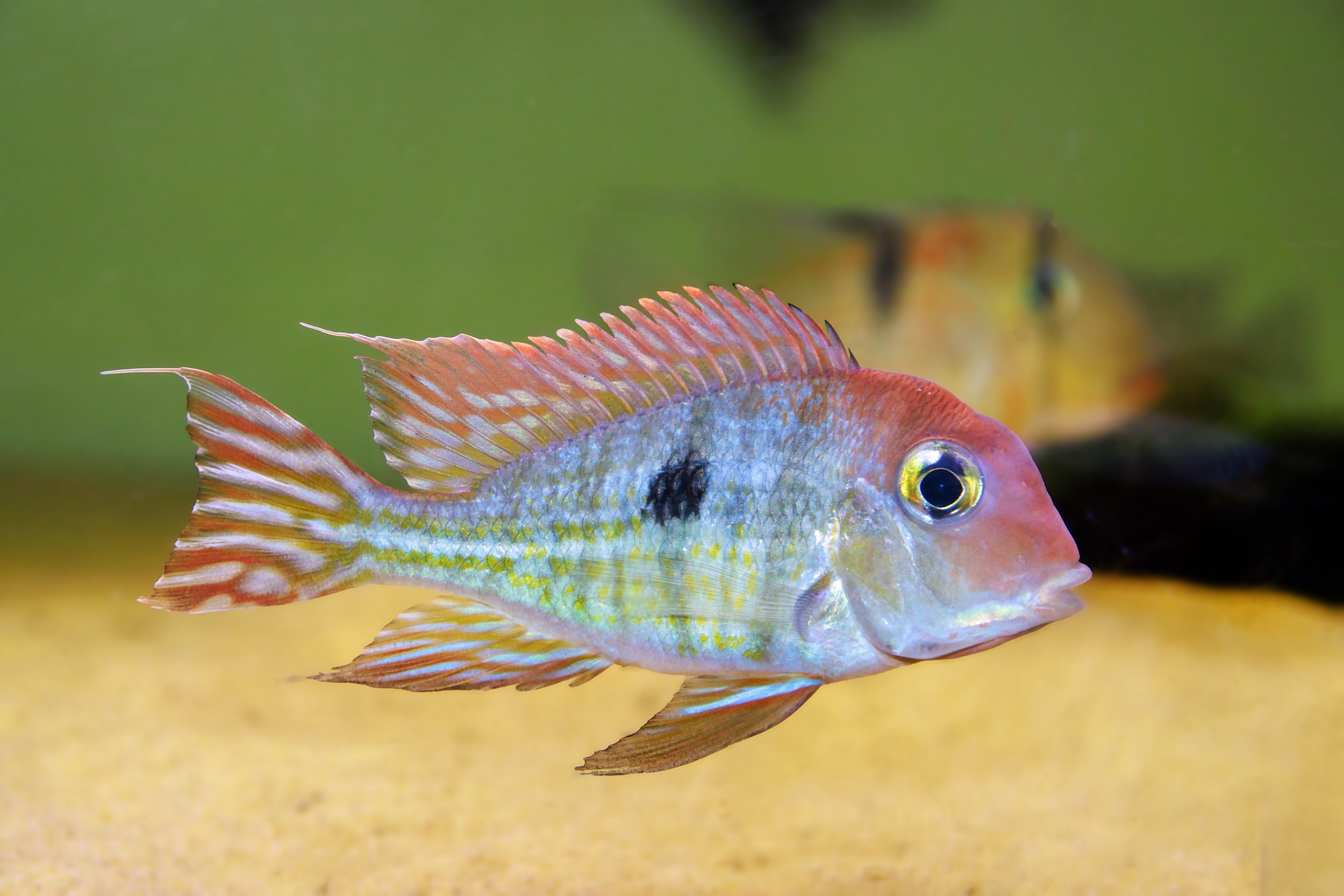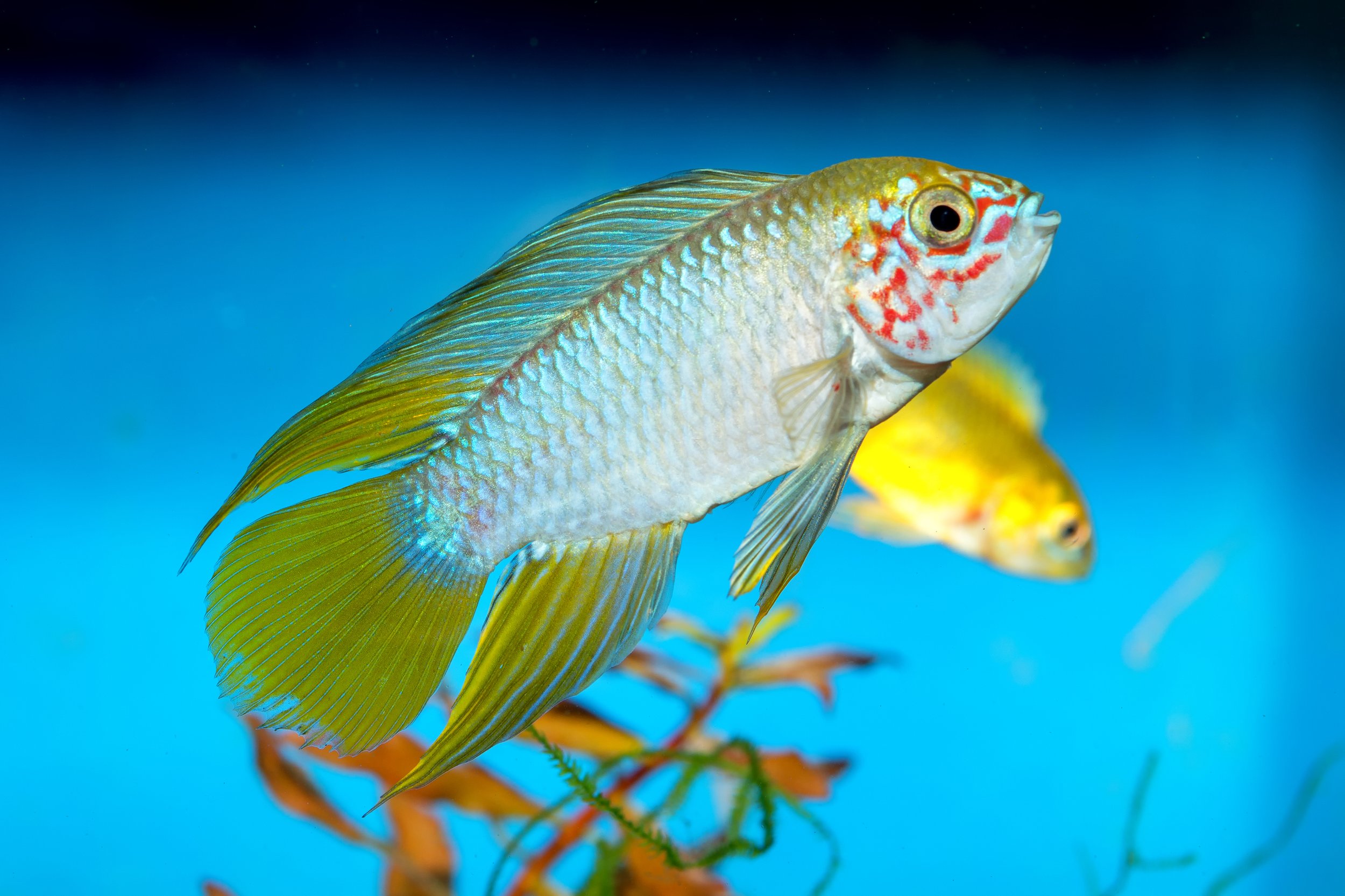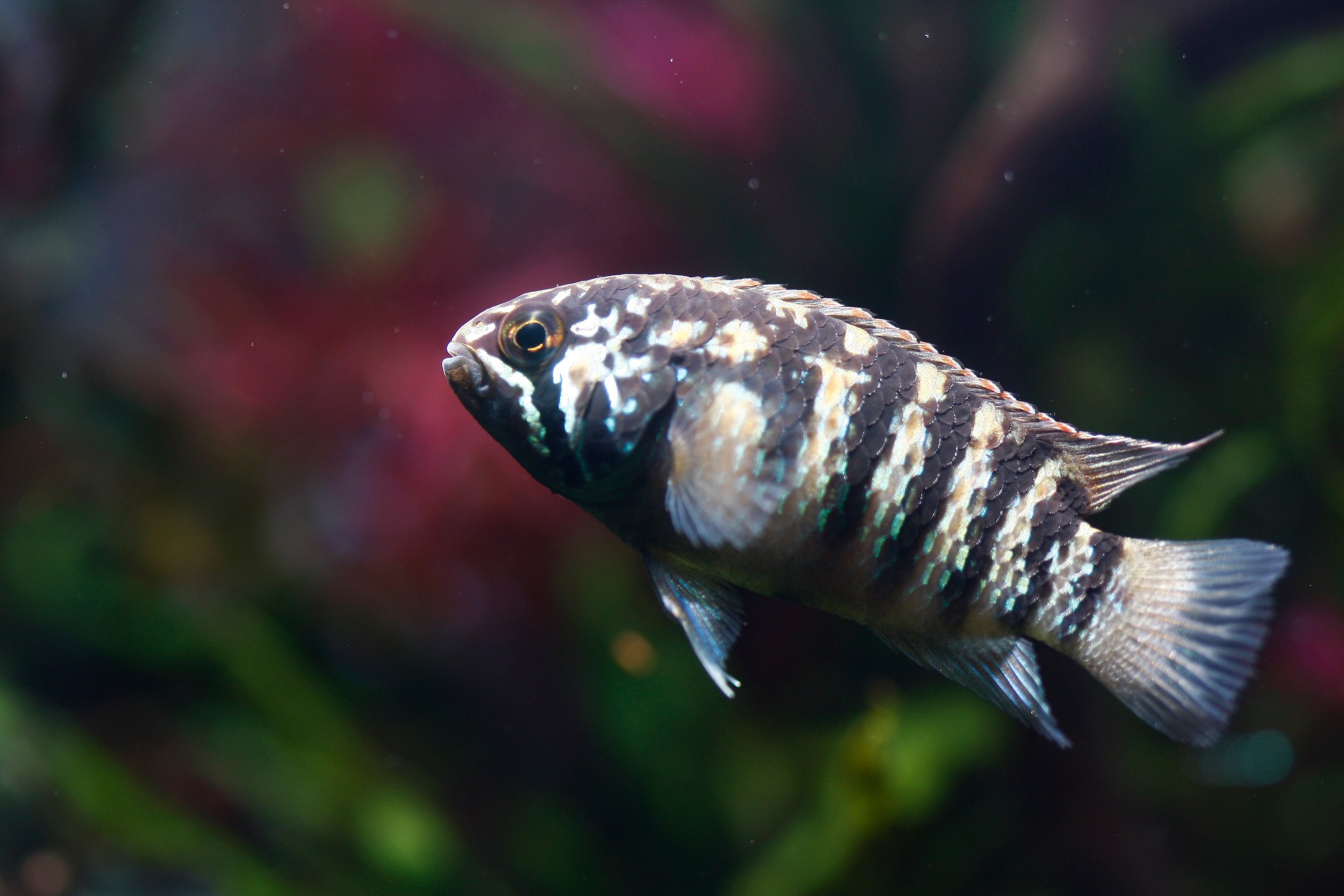 Image 1 of 2
Image 1 of 2

 Image 2 of 2
Image 2 of 2



Apistogramma bitaeniata-M
Apistogramma bitaeniata, commonly known as the Two-Stripe Dwarf Cichlid, is a visually stunning and highly sought-after freshwater fish native to the blackwater rivers and streams of the Amazon Basin in South America, particularly in Peru, Brazil, and Colombia. Known for its vibrant coloration, peaceful nature, and fascinating behavior, this species is a favorite among dwarf cichlid enthusiasts.
Physically, Apistogramma bitaeniata is named for the two horizontal stripes running along its body. The primary stripe extends from the snout through the eye to the base of the tail, while the second, subtler stripe runs parallel beneath it. Males are more colorful, displaying a dazzling mix of iridescent blue, green, and yellow hues, often with red or orange highlights on their fins. Females are smaller, less colorful, and more yellowish in appearance. Males grow up to 3 inches (7.5 cm) in length, while females remain slightly smaller, around 2 inches (5 cm).
In the aquarium, Apistogramma bitaeniata thrives in a well-planted setup with plenty of hiding spots, such as caves, driftwood, and leaf litter. A soft, sandy substrate is ideal, as these fish enjoy sifting through the sand in search of food. They prefer a tank of at least 20 gallons for a pair or small harem, with additional space required if housing them with other fish. Keeping them in a species-only tank or with peaceful, non-aggressive tank mates is recommended to reduce stress.
Water parameters for Apistogramma bitaeniata should mimic their natural blackwater environment. They prefer soft, acidic water with a pH range of 5.0 to 6.5 and temperatures between 75 to 82°F (24 to 28°C). These cichlids thrive in tannin-rich water created by adding driftwood, Indian almond leaves, or other botanicals. Clean, well-oxygenated water is essential, so regular water changes and efficient filtration are crucial.
Feeding Apistogramma bitaeniata is straightforward, as they are omnivores with a preference for protein-rich foods. They readily accept live or frozen foods such as brine shrimp, daphnia, bloodworms, and blackworms, as well as high-quality micro-pellets or flakes. Providing a varied diet helps maintain their health and enhances their vibrant coloration.
Breeding Apistogramma bitaeniata is achievable in captivity with the right conditions. They are cave spawners, and females will lay eggs on the ceiling or walls of a chosen cave. The female guards the eggs and fry, while the male defends the broader territory. Spawning can be encouraged by providing caves or small pots and maintaining slightly warmer water with soft, acidic conditions. The eggs hatch in 2 to 3 days, and the fry become free-swimming within a week. Fry can be fed infusoria or newly hatched brine shrimp.
Overall, Apistogramma bitaeniata is a stunning and rewarding species for aquarists who can provide the specific water conditions and care it requires. Its vivid colors, peaceful demeanor, and fascinating breeding behaviors make it a standout addition to well-maintained, species-specific, or South American biotope aquariums.
Apistogramma bitaeniata, commonly known as the Two-Stripe Dwarf Cichlid, is a visually stunning and highly sought-after freshwater fish native to the blackwater rivers and streams of the Amazon Basin in South America, particularly in Peru, Brazil, and Colombia. Known for its vibrant coloration, peaceful nature, and fascinating behavior, this species is a favorite among dwarf cichlid enthusiasts.
Physically, Apistogramma bitaeniata is named for the two horizontal stripes running along its body. The primary stripe extends from the snout through the eye to the base of the tail, while the second, subtler stripe runs parallel beneath it. Males are more colorful, displaying a dazzling mix of iridescent blue, green, and yellow hues, often with red or orange highlights on their fins. Females are smaller, less colorful, and more yellowish in appearance. Males grow up to 3 inches (7.5 cm) in length, while females remain slightly smaller, around 2 inches (5 cm).
In the aquarium, Apistogramma bitaeniata thrives in a well-planted setup with plenty of hiding spots, such as caves, driftwood, and leaf litter. A soft, sandy substrate is ideal, as these fish enjoy sifting through the sand in search of food. They prefer a tank of at least 20 gallons for a pair or small harem, with additional space required if housing them with other fish. Keeping them in a species-only tank or with peaceful, non-aggressive tank mates is recommended to reduce stress.
Water parameters for Apistogramma bitaeniata should mimic their natural blackwater environment. They prefer soft, acidic water with a pH range of 5.0 to 6.5 and temperatures between 75 to 82°F (24 to 28°C). These cichlids thrive in tannin-rich water created by adding driftwood, Indian almond leaves, or other botanicals. Clean, well-oxygenated water is essential, so regular water changes and efficient filtration are crucial.
Feeding Apistogramma bitaeniata is straightforward, as they are omnivores with a preference for protein-rich foods. They readily accept live or frozen foods such as brine shrimp, daphnia, bloodworms, and blackworms, as well as high-quality micro-pellets or flakes. Providing a varied diet helps maintain their health and enhances their vibrant coloration.
Breeding Apistogramma bitaeniata is achievable in captivity with the right conditions. They are cave spawners, and females will lay eggs on the ceiling or walls of a chosen cave. The female guards the eggs and fry, while the male defends the broader territory. Spawning can be encouraged by providing caves or small pots and maintaining slightly warmer water with soft, acidic conditions. The eggs hatch in 2 to 3 days, and the fry become free-swimming within a week. Fry can be fed infusoria or newly hatched brine shrimp.
Overall, Apistogramma bitaeniata is a stunning and rewarding species for aquarists who can provide the specific water conditions and care it requires. Its vivid colors, peaceful demeanor, and fascinating breeding behaviors make it a standout addition to well-maintained, species-specific, or South American biotope aquariums.
Apistogramma bitaeniata, commonly known as the Two-Stripe Dwarf Cichlid, is a visually stunning and highly sought-after freshwater fish native to the blackwater rivers and streams of the Amazon Basin in South America, particularly in Peru, Brazil, and Colombia. Known for its vibrant coloration, peaceful nature, and fascinating behavior, this species is a favorite among dwarf cichlid enthusiasts.
Physically, Apistogramma bitaeniata is named for the two horizontal stripes running along its body. The primary stripe extends from the snout through the eye to the base of the tail, while the second, subtler stripe runs parallel beneath it. Males are more colorful, displaying a dazzling mix of iridescent blue, green, and yellow hues, often with red or orange highlights on their fins. Females are smaller, less colorful, and more yellowish in appearance. Males grow up to 3 inches (7.5 cm) in length, while females remain slightly smaller, around 2 inches (5 cm).
In the aquarium, Apistogramma bitaeniata thrives in a well-planted setup with plenty of hiding spots, such as caves, driftwood, and leaf litter. A soft, sandy substrate is ideal, as these fish enjoy sifting through the sand in search of food. They prefer a tank of at least 20 gallons for a pair or small harem, with additional space required if housing them with other fish. Keeping them in a species-only tank or with peaceful, non-aggressive tank mates is recommended to reduce stress.
Water parameters for Apistogramma bitaeniata should mimic their natural blackwater environment. They prefer soft, acidic water with a pH range of 5.0 to 6.5 and temperatures between 75 to 82°F (24 to 28°C). These cichlids thrive in tannin-rich water created by adding driftwood, Indian almond leaves, or other botanicals. Clean, well-oxygenated water is essential, so regular water changes and efficient filtration are crucial.
Feeding Apistogramma bitaeniata is straightforward, as they are omnivores with a preference for protein-rich foods. They readily accept live or frozen foods such as brine shrimp, daphnia, bloodworms, and blackworms, as well as high-quality micro-pellets or flakes. Providing a varied diet helps maintain their health and enhances their vibrant coloration.
Breeding Apistogramma bitaeniata is achievable in captivity with the right conditions. They are cave spawners, and females will lay eggs on the ceiling or walls of a chosen cave. The female guards the eggs and fry, while the male defends the broader territory. Spawning can be encouraged by providing caves or small pots and maintaining slightly warmer water with soft, acidic conditions. The eggs hatch in 2 to 3 days, and the fry become free-swimming within a week. Fry can be fed infusoria or newly hatched brine shrimp.
Overall, Apistogramma bitaeniata is a stunning and rewarding species for aquarists who can provide the specific water conditions and care it requires. Its vivid colors, peaceful demeanor, and fascinating breeding behaviors make it a standout addition to well-maintained, species-specific, or South American biotope aquariums.






